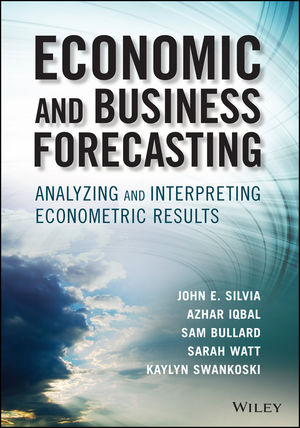
Economic and Business Forecasting
John Wiley & Sons Inc (Verlag)
978-1-118-49709-8 (ISBN)
Discover the secrets to applying simple econometric techniques to improve forecasting Equipping analysts, practitioners, and graduate students with a statistical framework to make effective decisions based on the application of simple economic and statistical methods, Economic and Business Forecasting offers a comprehensive and practical approach to quantifying and accurate forecasting of key variables. Using simple econometric techniques, author John E. Silvia focuses on a select set of major economic and financial variables, revealing how to optimally use statistical software as a template to apply to your own variables of interest.
Presents the economic and financial variables that offer unique insights into economic performance
Highlights the econometric techniques that can be used to characterize variables
Explores the application of SAS software, complete with simple explanations of SAS-code and output
Identifies key econometric issues with practical solutions to those problems
Presenting the "ten commandments" for economic and business forecasting, this book provides you with a practical forecasting framework you can use for important everyday business applications.
JOHN E. SILVIA is a Managing Director and the Chief Economist for Wells Fargo Securities. In 2010, he was recognized for the Best Inflation Forecast, the Best Overall Forecast, and the Best Personal Consumption Expenditures Forecast by The Federal Reserve Bank of Chicago. AZHAR IQBAL is an Econometrician and Vice President at Wells Fargo Securities where he provides quantitative analysis to the Economics group as well as modeling and forecasting of macro and financial variables. He has spoken at the American Economic Association, Econometric Society, and other international conferences. SAM BULLARD is a Managing Director and Senior Economist at Wells Fargo Securities providing analysis and commentary on financial markets and macroeconomic developments. SARAH WATT is an Economist with Wells Fargo Securities. She covers the U.S. macro economy, including labor market trends. She also works closely with senior members of her team to produce special reports and regional economic commentary on several U.S. states. KAYLYN SWANKOSKI is an Economic Analyst at Wells Fargo Securities.
Preface xiii
Acknowledgments xvii
Chapter 1 Creating Harmony Out of Noisy Data 1
Effective Decision Making: Characterize the Data 2
Chapter 2 First, Understand the Data 27
Growth: How Is the Economy Doing Overall? 30
Personal Consumption 31
Gross Private Domestic Investment 33
Government Purchases 35
Net Exports of Goods and Services 36
Real Final Sales and Gross Domestic Purchases 37
The Labor Market: Always a Core Issue 37
Establishment Survey 39
Data Revision: A Special Consideration 42
The Household Survey 43
Marrying the Labor Market Indicators Together 48
Jobless Claims 48
Inflation 49
Consumer Price Index: A Society’s Inflation Benchmark 50
Producer Price Index 53
Personal Consumption Expenditure Deflator: The Inflation Benchmark for Monetary Policy 55
Interest Rates: Price of Credit 56
The Dollar and Exchange Rates: The United States in a Global Economy 58
Corporate Profits 60
Summary 62
Chapter 3 Financial Ratios 63
Profitability Ratios 64
Summary 73
Chapter 4 Characterizing a Time Series 75
Why Characterize a Time Series? 76
How to Characterize a Time Series 77
Application: Judging Economic Volatility 101
Summary 109
Chapter 5 Characterizing a Relationship between Time Series 111
Important Test Statistics in Identifying Statistically Significant Relationships 115
Simple Econometric Techniques to Determine a Statistical Relationship 119
Advanced Econometric Techniques to Determine a Statistical Relationship 120
Summary 126
Additional Reading 127
Chapter 6 Characterizing a Time Series Using SAS Software 129
Tips for SAS Users 130
The DATA Step 131
The PROC Step 135
Summary 156
Chapter 7 Testing for a Unit Root and Structural Break Using SAS Software 157
Testing a Unit Root in a Time Series: A Case Study of the U.S. CPI 158
Identifying a Structural Change in a Time Series 162
The Application of the HP Filter 169
Application: Benchmarking the Housing Bust, Bear Stearns, and Lehman Brothers 172
Summary 177
Chapter 8 Characterizing a Relationship Using SAS 179
Useful Tips for an Applied Time Series Analysis 179
Converting a Dataset from One Frequency to Another 182
Application: Did the Great Recession Alter Credit Benchmarks? 215
Summary 221
Chapter 9 The 10 Commandments of Applied Time Series Forecasting for Business and Economics 223
Commandment 1: Know What You Are Forecasting 224
Commandment 2: Understand the Purpose of Forecasting 226
Commandment 3: Acknowledge the Cost of the Forecast Error 226
Commandment 4: Rationalize the Forecast Horizon 229
Commandment 5: Understand the Choice of Variables 231
Commandment 6: Rationalize the Forecasting Model Used 232
Commandment 7: Know How to Present the Results 234
Commandment 8: Know How to Decipher the Forecast Results 235
Commandment 9: Understand the Importance of Recursive Methods 238
Commandment 10: Understand Forecasting Models Evolve over Time 239
Summary 240
Chapter 10 A Single-Equation Approach to Model-Based Forecasting 241
The Unconditional (Atheoretical) Approach 242
The Conditional (Theoretical) Approach 251
Recession Forecast Using a Probit Model 257
Summary 261
Chapter 11 A Multiple-Equations Approach to Model-Based Forecasting 263
The Importance of the Real-Time Short-Term Forecasting 265
The Individual Forecast versus Consensus Forecast: Is There an Advantage? 266
The Econometrics of Real-Time Short-Term Forecasting: The BVAR Approach 268
Forecasting in Real Time: Issues Related to the Data and the Model Selection 275
Case Study: WFC versus Bloomberg 280
Summary 288
Appendix 11A: List of Variables 289
Chapter 12 A Multiple-Equations Approach to Long-Term Forecasting 291
The Unconditional Long-Term Forecasting: The BVAR Model 293
The BVAR Model with Housing Starts 296
The Model without Oil Price Shock 298
The Model with Oil Price Shock 304
Summary 306
Chapter 13 The Risks of Model-Based Forecasting: Modeling, Assessing, and Remodeling 307
Risks to Short-Term Forecasting: There Is No Magic Bullet 308
Risks of Long-Term Forecasting: Black Swan versus a Group of Black Swans 310
Model-Based Forecasting and the Great Recession/Financial Crisis: Worst-Case Scenario versus Panic 314
Summary 315
Chapter 14 Putting the Analysis to Work in the Twenty-First-Century Economy 317
Benchmarking Economic Growth 318
Industrial Production: Another Case of Stationary Behavior 322
Employment: Jobs in the Twenty-First Century 324
Inflation 331
Interest Rates 337
Imbalances between Bond Yields and Equity Earnings 338
A Note of Caution on Patterns of Interest Rates 345
Business Credit: Patterns Reminiscent of Cyclical Recovery 347
Profits 348
Financial Market Volatility: Assessing Risk 349
Dollar 351
Economic Policy: Impact of Fiscal Policy and the Evolution of the U.S. Economy 353
The Long-Term Deficit Bias and Its Economic Implications 358
Summary 362
Appendix: Useful References for SAS Users 365
About the Authors 367
Index 369
| Erscheint lt. Verlag | 9.5.2014 |
|---|---|
| Reihe/Serie | SAS Institute Inc |
| Verlagsort | New York |
| Sprache | englisch |
| Maße | 191 x 262 mm |
| Gewicht | 880 g |
| Themenwelt | Wirtschaft ► Volkswirtschaftslehre ► Mikroökonomie |
| Wirtschaft ► Volkswirtschaftslehre ► Ökonometrie | |
| ISBN-10 | 1-118-49709-0 / 1118497090 |
| ISBN-13 | 978-1-118-49709-8 / 9781118497098 |
| Zustand | Neuware |
| Haben Sie eine Frage zum Produkt? |
aus dem Bereich


